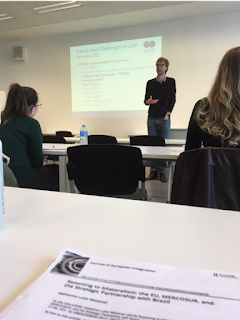By Lindsay Ozburn
This blog post was written for the course "Current Issues in Global and EU Affairs", which took place from February 12-April 30, 2018.
![A photograph of a barrier with khaki blankets and blue bunting draped over it. A hand-lettered sign peeks out from behind the blankets. Only phrases on the sign are visible: [in French] "Come join... friends of... violently expelled..." Behind the barrier are red, white, and blue umbrellas and an indistinct crowd of people.](https://4.bp.blogspot.com/-EtQXYSnolYY/WzVa2wB9luI/AAAAAAAAEuw/-rn9Uoz8u9En_lNw7JnDAOV-v_dNXnf-ACLcBGAs/s320/Sans_papiers_Bourse_mg_6904.jpg) |
Protest at the Bourse du Travail in Paris
Photograph by Rama, Wikimedia Commons, Cc-by-sa-2.0-fr |
Immigration patterns into the European Union (EU) over the last few decades have brought about a myriad of discussions of how to care for, integrate, assimilate, and/or “deal with” the presence of sometimes vastly different cultures and sheer volume of new individuals across the EU member states. These questions and discussions are by no means ‘new’. As a hub of economic freedom, democracy, and multiculturalism, the EU is routinely a landing zone for the disenfranchised, those fleeing persecution, and those wanting to experience the successes and freedoms offered by this powerful area of the world. Discussions about the strength of a common European culture and identity are ongoing (see Council of Europe, 2005), recognizing the fundamental role diversity plays in offering these offered freedoms. However, as geopolitics are ever in flux and have been more recently flowing toward nationalist and isolationist sentiment, conversations for addressing immigration have changed substantially in certain parts of the EU.
Depending on the time period (early 1990s, 2015, or sometime in-between) and the geographic location of the host country, these conversations range anywhere from supportive narratives aimed at integrating peacefully and holistically new groups of immigrants (take Sweden and Germany, for example) – regardless of their status as either a refugee, asylum seeker, or economic immigrant – to threatening narratives that seemed geared toward ‘damage control’ and the quick assimilation or ejection of said immigrants (take Hungary, for example). The difference in the underlying assumptions behind these different narratives is that one (positive narratives) assumes the immigrants are likely to stay within the host country regardless of the circumstance from which they came; and the other (negative narratives) insists on returning to the status quo as soon as the refugee/asylum seeker’s sending country is safe, if not sooner. These positive narratives focus on proactive responses to immigration: occupational skills training (see Androulakis et al, 2017), mentor-based language immersion courses, community forums to bridge cultural divides (see Sjösvärd and Braddell, 2017), etc. The negative narratives focus on reactive responses aimed at triaging what are seen as negative impacts on the host society: forced detention camps, unattainable citizenship requirements (see Pulinx and Avermaet, 2017), repatriation, etc.
Both are presented as approaches to immigration control, sometimes in an effort to ensure the ‘European identity’ and ‘European way of life’ is maintained. We must ask ourselves, though: what
is the European identity? We must ask the same question in the United States (US), particularly as immigration reform is rapidly shifting further toward xenophobia and isolationism through the use of curt words and an insistence on the power of walls to keep out unwanted ‘guests’. Are these European and American identities static, reflecting the individual cultures passed down through history and evident in the majority of each country’s infrastructure and society; or are they constantly in flux, accepting the reality that Europe, the US, and other ‘Great Powers’, are rooted as much in their history of freedom as they are tied to the multicultural groups of people who seek and fight for it (and have always done so)? If the later, then positive narratives aimed at cohabitating and integrating with newcomers to European societies and likewise to the US will continue to prove successful by teaching tolerance and acceptance with the understanding that this is a large world we live in and that differences are to be expected and cherished to ensure progress – as is the free movement of peoples in our irreversibly-globalized world. If the later, then, much like the static structures those sentiments cherish, any attempt at common identities and cohesiveness will crumble with the changing immigration tides.
__________________
References:
Androulakis G, Gkaintartzi A, Kitsiou R, and Tsioli S (2017) Research-driven task-based L2 learning for adult immigratns in times of humanitarian crisis: results from two nationwide projects in Greece.
De Gruyter. DOI: 10.1515/9783110477498-024
Council of Europe. European Culture: Identity and Diversity. In:
Colloquy of the Council of Europe in cooperation with the French Minister of Culture and Communication and the City of Strasbourg, Museum of Modern and Contemporary Art, 8-9 September 2005. Available at: https://www.coe.int/t/dg4/CulturalConvention/Source/CIMasterdoc_EN.pdf
Pulinx R and Avermaet P V (2017) The impact of language and integration policies on the social participation of adult migrants.
De Gruyter. DOI: 10.1515/9783110477498-008
Sjösvärd K and Braddell A (2017) Using workplace learning to support the linguistic integration of adult migrants – lessons from a decade of work in Sweden.
De Gruyter. DOI: 10.1515/9783110477498-044
![A photograph of a barrier with khaki blankets and blue bunting draped over it. A hand-lettered sign peeks out from behind the blankets. Only phrases on the sign are visible: [in French] "Come join... friends of... violently expelled..." Behind the barrier are red, white, and blue umbrellas and an indistinct crowd of people.](https://4.bp.blogspot.com/-EtQXYSnolYY/WzVa2wB9luI/AAAAAAAAEuw/-rn9Uoz8u9En_lNw7JnDAOV-v_dNXnf-ACLcBGAs/s320/Sans_papiers_Bourse_mg_6904.jpg)



